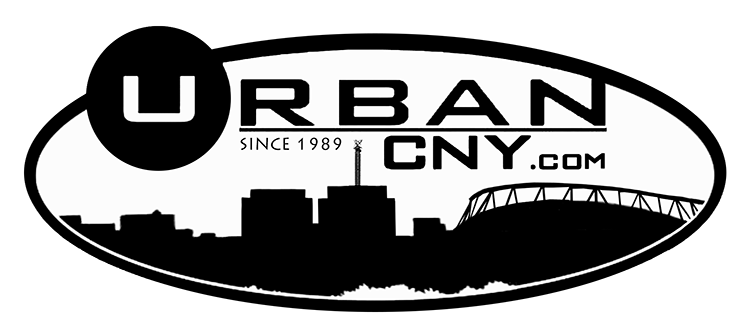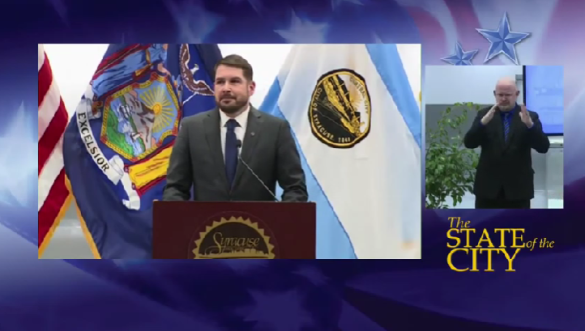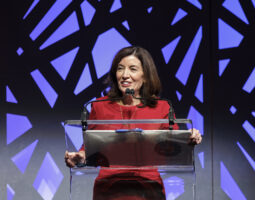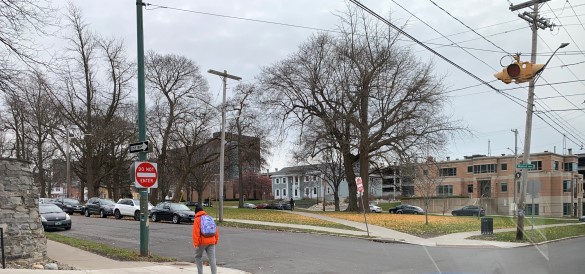In 2022 State of the City Address, Mayor Walsh Says Syracuse Is Resilient and Ready to Reach Higher for Greater Progress and Opportunity for All
Mayor announces new programs and investments in public safety, housing, neighborhoods, parks and economic development Walsh will create the new Mayor’s Office to Reduce Gun Violence Mayor reports FY 2021 surplus of $38 million and fund balance of $80 million; combination gives the City more time to fix structural deficit Syracuse, N.Y. – In his fifth State of the City address, Syracuse Mayor Ben Walsh announced programs and proposals to improve public safety; invest in housing, neighborhoods and parks; and expand economic development. Walsh said Syracuse is “resilient and ready” to reach higher for greater progress and opportunity for all. Mayor Walsh delivered his annual address to the Syracuse Common Council from the production floor of the new JMA Wireless 5G manufacturing facility in the City of Syracuse. The first new factory in the city in decades, the plant will go in to operation in February. Walsh said conditions are aligned more favorably for the City than at any time in a half century. He cited improving fiscal health for the City, American Rescue Plan Act pandemic relief, upcoming Bipartisan Infrastructure Framework spending, the impending start of the Interstate 81 project and a rising sense of belief in progress among city residents. “Things have never lined up better. But how will we respond to this remarkable moment in Syracuse history? We have a mandate to reach higher; to collaborate more completely in the next four years. I have no ambition greater than to work in partnership with you to speed Syracuse’s path to our best days ever. This amazing facility is an example of what we can achieve together,” Walsh said, referring to the JMA Wireless tech manufacturing campus. “It is a critical component of the Syracuse Surge which the Common Council embraced with its bold support to acquire and upgrade our street light network to put Syracuse on the map among the world’s most forward looking smart cities.” Mayor’s Office to Reduce Gun Violence Mayor Walsh announced the creation of the City’s first Mayor’s Office to Reduce Gun Violence. The new office will be staffed by a full time director and will work alongside residents, community stakeholders, law enforcement and violence prevention experts to identify factors perpetuating gun violence in Syracuse. It will also implement strategic solutions informed by proven best practices. The City is accepting applications for the director position until January 28, 2022. “As we have painfully experienced in the past year, the lack of opportunity, addiction and trauma drive too many people to dangerous and violent acts,” Walsh said. “I believe the fight against gun crime is a war that can be won. We will save precious lives and Syracuse will show the nation how a city successfully turns back gun violence.” Connecting the New 15th Ward – Choice Neighborhoods Initiative Mayor Walsh announced the City will submit a massive proposal to the U.S. Department of Housing and Urban Development’s premier place-based initiative, the Choice Neighborhoods Initiative, for $50 million in federal money to comprehensively invest in the East Adams corridor, known as the 15th Ward. The grant application is the next step toward realizing the resident-driven transformation of the neighborhood being planned by the Syracuse Housing Authority and Blueprint 15 in association with the nationally-proven Purpose Built Communities model. The result will be an $800 million in investment bringing all of the SHA housing in the neighborhood – more than 1,000 units – up to modern standards that their residents deserve. “The 15th Ward is a place with unwavering spirit despite enduring an injustice that has lasted more than half a century. Across our nation, there is no greater example of the destructive impact of urban highways on neighborhoods than the Interstate 81 viaduct. We must and will right this wrong,” Mayor Walsh said. “The possibilities for the 15th Ward have been envisioned by residents – parks, transportation, child care, retail and mixed-income housing – and they are exciting. I want to be clear, though, about one critical point: preventing displacement of current residents is central to this transformation. I will not accept an approach that triggers gentrification or forces families to leave a neighborhood they love and call home.” Parks Programs for Families, Health and Wellness, and Therapeutic Recreation Mayor Walsh announced the Syracuse Department of Parks Recreation and Youth Programs will create three new bureaus that recognize the critical roles that parks play in our lives. Health and Wellness Bureau: to coordinate and expand our programs in yoga, running, dance and other mental health and physical fitness programs. Therapeutic Recreation Bureau: for the many members of our community with mental, emotional and physical needs. The bureau will be staffed by a therapeutic recreation specialist to create and operate sports, arts and crafts, dance, music and other programs to reduce stress, improve functioning and build confidence. Family Recreation Bureau: to respond to the exploding demand for new family programs, like pop-up equipment rentals, community events and races in all seasons. “The people of Syracuse are served with a spectacular network of parks and a robust portfolio of recreation programs for seniors, youth and people of all ages,” Walsh said. “In 2022, Parks will reach higher levels.” Syracuse Surge Progress: Tech Manufacturing and Housing at Former SDC Property The Mayor’s address reviewed the broad progress accomplished during the past three years on the Syracuse Surge, the City’s strategy for inclusive growth in the New Economy. In a new development for the Syracuse Surge, Walsh announced the City is working with CenterState CEO to attract a high-tech company and build an advanced manufacturing facility at the vacant Syracuse Development Center property on the West Side. The abandoned and vandalized structure will be demolished and replaced with a modern, job creating manufacturing, research and technology campus. The City also signed a letter of intent with CenterState CEO and the Albanese Organization, a leading Northeast development firm that wants to invest in Syracuse to bring a mixed income housing development to the SDC property. “This 48-acre site











